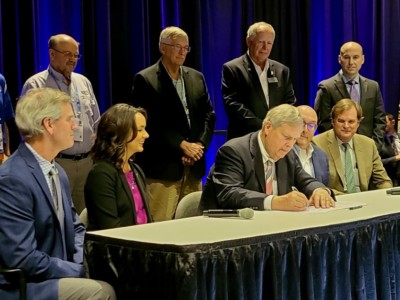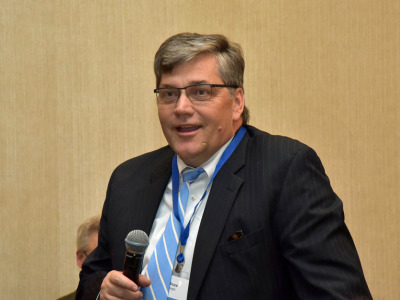The Agriculture Department is working with groups involved in the $3.1 billion Partnerships for Climate-Smart Commodities program to provide flexibility to farmers on how they plant cover crops, in order to ensure enough farmers sign up for the projects.
The program is a first-of-its-kind attempt to gather data on a wide variety of practices across more than 25 million acres in order to develop climate-smart commodities. The department estimates that the projects will sequester more than 60 million metric tons of carbon dioxide equivalent, “equivalent to removing more than 12 million gasoline-powered passenger vehicles from the road for one year.”
But differences in Natural Resources Conservation Service standards for cover crops in different states have proven to be a sticking point, and USDA is working with groups taking part in the projects to give producers leeway to deviate somewhat from the practices prescribed by those state NRCS offices.
“We do believe that there is room for us to make things work in every single state,” said Dave Gagner, senior director of government relations at the National Fish and Wildlife Foundation, the lead partner for one of the two projects — out of 141 — that has signed a contract with USDA. “We've already opened those discussions with USDA at multiple different levels to say, what can we do?”
However, “We think we're going to have to negotiate that” flexibility with NRCS state conservationists in 20 states, he said. “Obviously, that's a lot.”
NWF's “Farmers for Soil Health” project includes the National Corn Growers Association, the United Soybean Board, and the National Pork Board, as well as the National Center for Appropriate Technology, National Association of Conservation Districts, Soil Health Institute, University of Missouri, The Sustainability Consortium, Data Transmission Network, and MBSH Consulting.
USDA has agreed to pay $95 million for the project over five years. Farmers will receive $50 per acre for new cover crops over three years — $25 per acre the first year, $15 in the second, and $5 in the third. Farmers for Soil Health, which was established prior to PCSC grant funding, has a broader goal of getting cover crops on 30 million acres by 2030.
 Ag Secretary Tom Vilsack signs the Farmers for Soil Health agreement at the 2023 Commodity Classic
Ag Secretary Tom Vilsack signs the Farmers for Soil Health agreement at the 2023 Commodity ClassicMany of the projects due to receive funding involve cover crops. But some farmers are balking at having to comply with NRCS practice standards.
The Illinois Corn Growers Association, which is involved in the Farmers for Soil Health project, said in a letter to Illinois Sens. Dick Durbin and Tammy Duckworth, both Democrats, that the NRCS practice standard for cover crop management in Illinois and Kentucky “discourages farmers from adopting or scaling cover crops in these states due to the higher costs and greater risks” caused by requirements for higher seeding rates or termination requirements.
“NRCS practice standards also don’t recognize the greater challenge of growing cover crops before a corn crop (versus soybean) or the myriad of different technologies that farmers have adapted for seeding cover crops to maximize their nutrient loss reduction benefits, soil erosion benefits, and added biodiversity (e.g. using split row planters to seed cover crops),” the association said.
Greg Goodwin, director of the Precision Conservation Management (PCM) program at Illinois Corn, said farmers want to be able to innovate, and adhering solely to NRCS practice standards could blunt new ideas.
“We’re just really trying to protect an opportunity for farmers to try things on their own terms to scale conservation practice adoption,” he said. “We feel this will not only enhance enrollment, but also give us a greater chance to learn from early adopters who may not always be adherent to standards, but have experience adopting these practices in a profitable way — something that's a little more universal and gets away from being prescriptive.
“We have a very diverse state and therefore we feel building in flexibility will be key in scaling adoption of cover crops,” Goodwin added.
Asked about the status of PCSC negotiations, USDA Acting Senior Adviser for Climate-Smart Commodities Katina Hanson said in an email that the department is now “meeting with tentative selectees and partners as appropriate to help us all to move forward with strong agreements that include good strategies to benefit producers.”
Hanson cited language from the PCSC’s February 2022 Notice of Funding Availability saying that “practices and enhancements to existing practices are not limited to those under existing USDA practice standards; however, compliance and reporting activities will likely be more complex for practices without existing standards.”
“This language applies to the project applicant, as they need to provide to us a clear description of the alternative standard that is planned to be applied, and we need to evaluate if any separate reporting or additional analysis is needed,” Hanson said.
Illinois Corn also is involved in a project led by Field to Market, the Climate-Smart Agriculture Innovative Finance Initiative, which is in the final stages of contract negotiations, Goodwin said. The Farmers for Soil Health contract has been signed, but funding agreements to state-lead groups for technical assistance are still being negotiated, he said.
Another concern is the potential need for a review under the National Environmental Policy Act for certain projects, if the practice standards aren’t employed.
In its letter, Illinois Corn said it understood how NEPA would apply “if the practices suggested were converting land or equating to land disturbance beyond standard agricultural practices; however, in this scenario that is not the case, and this measure seems unnecessary.”
Gagner, a former chief of staff and director of strategic natural resources issues at NRCS, said he expects to receive a letter from USDA soon outlining its obligations for environmental review of the project. Seeking formal amendments to practice standards can take a year or more, and “that’s not what we or USDA leadership believe we have in terms of timing,” he said.
 Bruce Knight, Strategic Conservation Solutions
Bruce Knight, Strategic Conservation SolutionsBruce Knight, a former NRCS chief from 2002 to 2006 and current principal and founder of Strategic Conservation Solutions, said NRCS’s national practice standards “are in fact, written in a manner in which they should be very flexible. And the practice standard that is written by NRCS needs to work as well in Maine as it does in Montana.”
When it comes to cover crops, however, he said state conservationists can add specific requirements, and “at any given time, you'll run into difficulties where someone is trying to implement the practice standards in a way that is more specific than is needed.”
Don’t miss a beat! It’s easy to sign up for a FREE month of Agri-Pulse news! For the latest on what’s happening in Washington, D.C. and around the country in agriculture, just click here.
“I think folks are running into difficulties of how to deal with those interpretations and how to work through those,” Knight said. “But as NRCS moves forward on this … they're going have to be a lot more flexible.”
He called it a “crying shame” that agreements announced in September are still being negotiated, “because people are missing the opportunity to sign up producers who wanted to be involved in these climate change activities. … Unfortunately, the bureaucracy is simply not moving at the pace that the secretary is clearly expecting it to.”
At the same time, Knight said the grantees need to be aware that “free money is never free.”
The $3.1 billion allocated to projects is taxpayer money, and there is “a certain degree of performance that needs to be delivered, both by the (nongovernmental organizations) that are delivering it, and by the farmer,” Knight said. “Government programs come with government rules.” Knight said.
For more news, go to www.Agri-Pulse.com.


